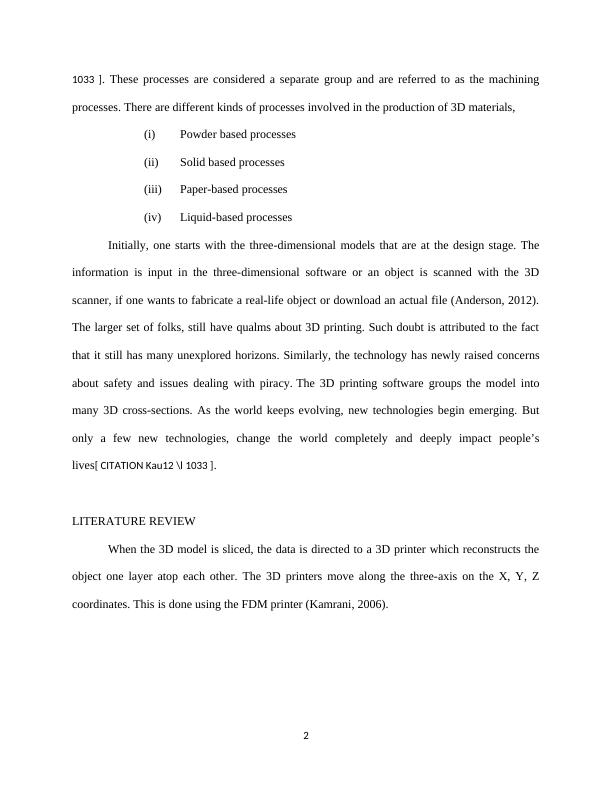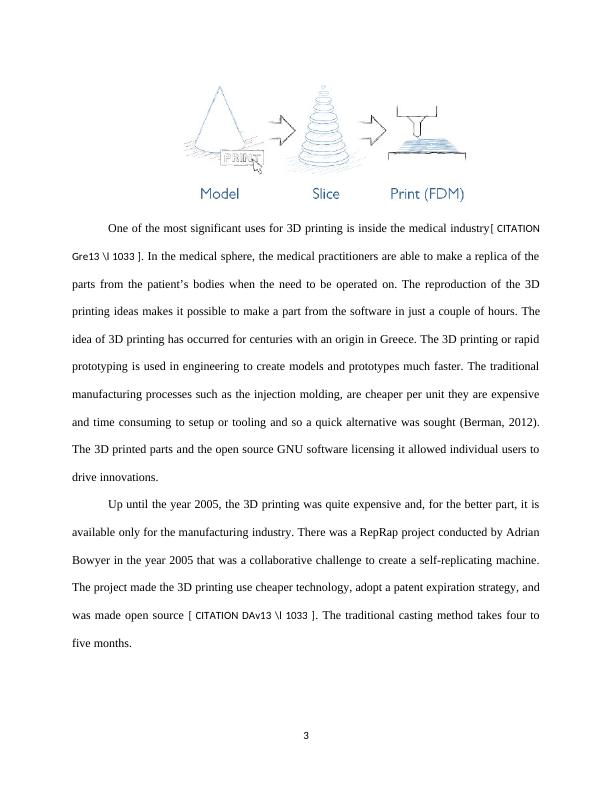Paper on 3D printing Activities and Processes
9 Pages2404 Words84 Views
Added on 2020-04-07
Paper on 3D printing Activities and Processes
Added on 2020-04-07
ShareRelated Documents
3D PRINTINGABSTRACTThis paper seeks to comprehend the information behind the 3D printing activities andprocesses. The 3D printing has a history from the early centuries in Greece where 3D objectswere made similarly to each other. The printing involves the modelling and design, developmentin the software and finally machining. There is a business side to the same concerned on thereturn on investment and increase in the number of sales. It is considered as additivemanufacturing that is due to the fact that instead of removing material to create a part or theentire design model (Hobson, 2012). The design undergoes prototyping of specialized parts andconsiders other future applications. The 3D printing technique solves some of the shortcomingsof the traditional machining technologies used in production at industrial or manufacturing level. Key Words: FDM, Machining, 3D printing, prototyping, design models, SLT.INTRODUCTION3D printable models are generated using the computer aided design software through athree-dimensional scanner or from an ordinary cardinal camera or software. The blue-collarmodelling process of fixing geometric data for three-dimensional mainframe graphics isanalogous to the physical molding of objects (Fratzl, 2007). In 3D printing, there is an additiveindustrial course that creates the three-dimensional objects from the 3D digital informationprovided. The three-dimensional digital models are sliced into many 2D cross-sections. Thesesectional parts are then printed out on top of each other. There are other 3D printers that aresubtractive manufacturing processes such as the CNC and milling processes[ CITATION Lip13 \l1

1033 ]. These processes are considered a separate group and are referred to as the machiningprocesses. There are different kinds of processes involved in the production of 3D materials,(i)Powder based processes(ii)Solid based processes(iii)Paper-based processes(iv)Liquid-based processesInitially, one starts with the three-dimensional models that are at the design stage. Theinformation is input in the three-dimensional software or an object is scanned with the 3Dscanner, if one wants to fabricate a real-life object or download an actual file (Anderson, 2012).The larger set of folks, still have qualms about 3D printing. Such doubt is attributed to the factthat it still has many unexplored horizons. Similarly, the technology has newly raised concernsabout safety and issues dealing with piracy.The 3D printing software groups the model intomany 3D cross-sections. As the world keeps evolving, new technologies begin emerging. Butonly a few new technologies, change the world completely and deeply impact people’slives[ CITATION Kau12 \l 1033 ].LITERATURE REVIEWWhen the 3D model is sliced, the data is directed to a 3D printer which reconstructs theobject one layer atop each other. The 3D printers move along the three-axis on the X, Y, Zcoordinates. This is done using the FDM printer (Kamrani, 2006).2

One of the most significant uses for 3D printing is inside the medical industry[ CITATIONGre13 \l 1033 ]. In the medical sphere, the medical practitioners are able to make a replica of theparts from the patient’s bodies when the need to be operated on. The reproduction of the 3Dprinting ideas makes it possible to make a part from the software in just a couple of hours.Theidea of 3D printing has occurred for centuries with an origin in Greece. The 3D printing or rapidprototyping is used in engineering to create models and prototypes much faster. The traditionalmanufacturing processes such as the injection molding, are cheaper per unit they are expensiveand time consuming to setup or tooling and so a quick alternative was sought (Berman, 2012).The 3D printed parts and the open source GNU software licensing it allowed individual users todrive innovations. Up until the year 2005, the 3D printing was quite expensive and, for the better part, it isavailable only for the manufacturing industry. There was a RepRap project conducted by AdrianBowyer in the year 2005 that was a collaborative challenge to create a self-replicating machine.The project made the 3D printing use cheaper technology, adopt a patent expiration strategy, andwas made open source [ CITATION DAv13 \l 1033 ]. The traditional casting method takes four tofive months. 3

End of preview
Want to access all the pages? Upload your documents or become a member.
Related Documents
3D Printing: Definition, Operation and Applicationslg...
|8
|1633
|378
3D Printer in Mechanical Design: Applications and Techniqueslg...
|8
|1577
|487
(PDF) The Processes and Technologies of 3D Printinglg...
|5
|2828
|46
Report on 3D Printing (Doc)lg...
|10
|2000
|78
Discover the World of 3D Printing: A Comprehensive Guide to 3D Printer Technologylg...
|17
|5748
|60
3D PRINTER About 3D printer and its working 3D printinglg...
|17
|5709
|186
